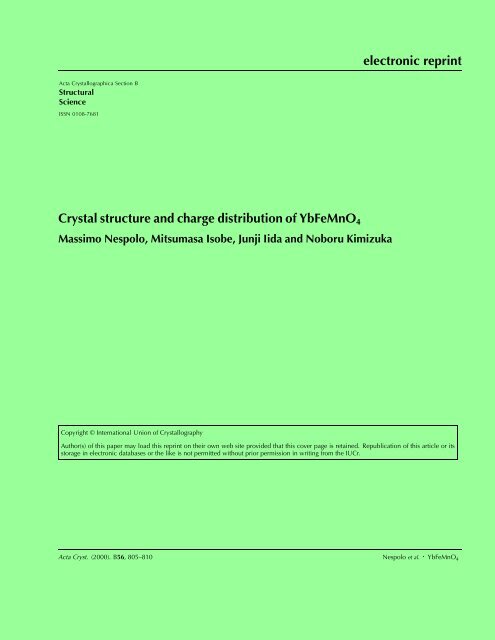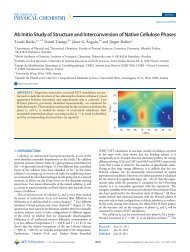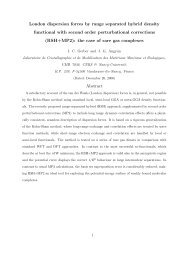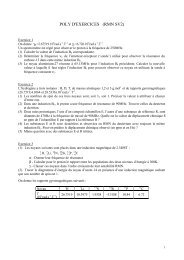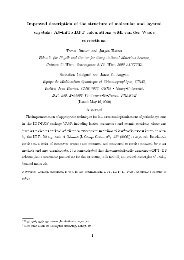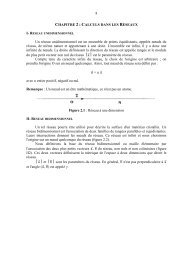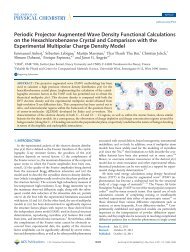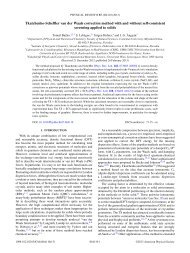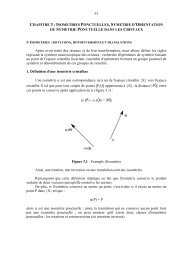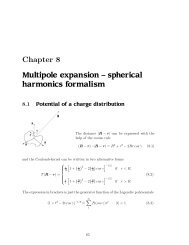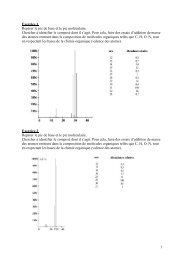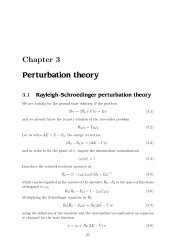electronic reprint Crystal structure and charge distribution of ... - CRM2
electronic reprint Crystal structure and charge distribution of ... - CRM2
electronic reprint Crystal structure and charge distribution of ... - CRM2
Create successful ePaper yourself
Turn your PDF publications into a flip-book with our unique Google optimized e-Paper software.
<strong>electronic</strong> <strong>reprint</strong>Acta <strong>Crystal</strong>lographica Section BStructuralScienceISSN 0108-7681<strong>Crystal</strong> <strong>structure</strong> <strong>and</strong> <strong>charge</strong> <strong>distribution</strong> <strong>of</strong> YbFeMnO 4Massimo Nespolo, Mitsumasa Isobe, Junji Iida <strong>and</strong> Noboru KimizukaCopyright © International Union <strong>of</strong> <strong>Crystal</strong>lographyAuthor(s) <strong>of</strong> this paper may load this <strong>reprint</strong> on their own web site provided that this cover page is retained. Republication <strong>of</strong> this article or itsstorage in <strong>electronic</strong> databases or the like is not permitted without prior permission in writing from the IUCr.Acta Cryst. (2000). B56, 805–810 Nespolo et al.¯ YbFeMnO 4
esearch papersActa <strong>Crystal</strong>lographica Section BStructuralScienceISSN 0108-7681<strong>Crystal</strong> <strong>structure</strong> <strong>and</strong> <strong>charge</strong> <strong>distribution</strong> <strong>of</strong>YbFeMnO 4Massimo Nespolo, a * MitsumasaIsobe, a ² Junji Iida b <strong>and</strong> NoboruKimizuka ca National Institute for Research in InorganicMaterials, Research Centre for Creating NewMaterials, 1-1 Namiki, Tsukuba, 305-0044Ibaraki, Japan, b Sumitomo Metal Mining Co.Ltd, Technology Division, 3-18-5 Nakakokubun,Ichikawashi, Chiba 272-0835, Japan,<strong>and</strong> c Universidad de Sonora, Departamento deInvestigaciones en Polimeros y Materiales,Hermosillo, Sonora, CP 83000 Mexico² Deceased 1994.Correspondence e-mail: nespolo@nirim.go.jpThe <strong>structure</strong> <strong>of</strong> synthetic YbFeMnO 4 has been re®ned bysingle-crystal X-ray diffraction. Space group R3Åm, a =3.4580 (1), c = 25.647 (3) A Ê , V = 265.59 (3) A Ê 3 , Z =3.Ybisin octahedral coordination, whereas Fe <strong>and</strong> Mn are disorderedon a single crystallographic type <strong>of</strong> trigonal bipyramid, inwhich the cation is <strong>of</strong>f-centred from the basal plane. Assumingperfect stoichiometry, R 1 = 0.0195, but the <strong>charge</strong> <strong>distribution</strong>(CD) analysis suggests incomplete occupation <strong>of</strong> the Yb site.Re®nement <strong>of</strong> the occupancy lowers R 1 to 0.0175, resulting ins.o.f.(Yb) = 0.963 (3), with a signi®cant improvement <strong>of</strong> theFourier difference. The electroneutrality is likely preservedthrough incomplete occupancy <strong>of</strong> one <strong>of</strong> the two oxygen sites:the compound is thus non-stoichiometric, with the formulaYb 0.963 FeMnO 3.945 . Another mechanism for preserving theelectroneutrality is the oxidation <strong>of</strong> a small amount <strong>of</strong> Mn 2+ toMn 3+ , which is, however, less probable because <strong>of</strong> thereduction conditions in which the sample was synthesized.Both models give a satisfactorily CD result, but they cannot bede®nitively distinguished by X-ray data.Received 13 March 2000Accepted 7 April 2000# 2000 International Union <strong>of</strong> <strong>Crystal</strong>lographyPrinted in Great Britain ± all rights reservedActa Cryst. (2000). B56, 805±810 Nespolo et al. YbFeMnO 4 8051. IntroductionCompounds with layer <strong>structure</strong> <strong>and</strong> high electric conductivityhave been the subject <strong>of</strong> intensive research over the last 30years. The binary R 2 O 3 ±MO <strong>and</strong> ternary R 2 O 3 ±A 2 O 3 ±MO orR 2 O 3 ±TiO 2 ±MO systems (R = In, Ga or a rare earth element;A = In, Ga, Fe, Al; M = Mg, Mn, Fe, Co, Cu, Zn, Cd) have beeninvestigated to clarify the synthesis conditions, phase relations,<strong>and</strong> stabilities <strong>and</strong> magnetic properties (Kimizuka et al., 1990,1993, 1995; Siratori, 1993; Iida et al., 1990; Nakamura et al.,1990, 1993a,b; Yamaguchi et al., 1991; Nakamura & Kimizuka,1993; Brown et al., 1999). Structural studies have consideredboth the local <strong>structure</strong>, through high-resolution transmissionelectron microscopy (HRTEM) <strong>and</strong>/or electron diffraction(Matsui et al., 1979; Matsui, 1980; Cannard & Tilley, 1988;Uchida et al., 1994; HoÈ rlin et al., 1998; Li et al., 1997, 1998,1999a,b; Li, B<strong>and</strong>o, Nakamura, Kurashima & Kimizuka, 1999;Wolf & Mader, 1999), <strong>and</strong> the global one, through powder(Cannard & Tilley, 1988; Nakamura & Kimizuka, 1993; Cava etal., 1998; Moriga et al., 1999) <strong>and</strong> single-crystal X-raydiffraction (Geller et al., 1975; Kato et al., 1975, 1976; Malamanet al., 1975, 1976; Isobe et al., 1990, 1991, 1994; Nespolo,Nakamura & Ohashi, 2000; Nespolo, Sato et al., 2000).The structural motif <strong>of</strong> this type <strong>of</strong> compound consists <strong>of</strong>layers <strong>of</strong> octahedrally coordinated R 3+ cations alternated withlayers <strong>of</strong> M 2+ /M 3+ cations in trigonal bipyramidal coordination.Barbier (1989) has pointed out that the cation closepacking is much more regular than the oxygen packing. Thestacking <strong>of</strong> these layers along the c direction produces accre<strong>electronic</strong><strong>reprint</strong>
esearch papersTable 1Experimental details for YbFeMnO 4 .<strong>Crystal</strong> dataCell settingHexagonalSpace groupR3 ma (A Ê ) 3.4580 (1)c (A Ê ) 25.647 (3)V (A Ê 3 ) 265.59 (3)Z 3Radiation typeMo KWavelength (A Ê ) 0.71073No. <strong>of</strong> re¯ections for cell parameters 18 range ( ) 40.98±45.30Temperature (K) 293 (2)<strong>Crystal</strong> formSphere<strong>Crystal</strong> radius (mm) 0.055<strong>Crystal</strong> colourBlackData collectionDiffractometerEnraf±Nonius CAD-4Data collection method!± scansAbsorption correctionSphereT min 0.086T max 0.166No. <strong>of</strong> measured re¯ections 655No. <strong>of</strong> independent re¯ections 577No. <strong>of</strong> observed re¯ections 528Criterion for observed re¯ectionsI > 2(I)R int 0.0196 max ( ) 59.84Range <strong>of</strong> h, k, l 0 ! h ! 70 ! k ! 460 ! l ! 61No. <strong>of</strong> st<strong>and</strong>ard re¯ections 3Frequency <strong>of</strong> st<strong>and</strong>ard re¯ectionsEvery 240 minIntensity decay (%) 0.5Re®nementRe®nement on F 2s.o.f. (Yb) = 1 s.o.f. (Yb) = 0.963Chemical formula weight 347.83 341.49D x (Mg m 3 ) 6.524 6.405 (mm 1 ) 33.593 32.637R‰F 2 >2…F 2 †Š 0.0195 0.0175wR…F 2 † 0.0524 0.0437S 1.153 1.184No. <strong>of</strong> re¯ections used 577 577in re®nementNo. <strong>of</strong> parameters used 13 14…=† max 0.000 0.001 max (e A Ê 3 ) 3.39 at 2/3,1/3,0.1059(0.30 A Ê from Fe/Mn)2.55 at 0,0,0.1109(0.44 A Ê from O1) min (e A Ê 3 ) 6.20 at 0,0,0.0214(0.55 A Ê from Yb)4.88 at 0,0,0.0217(0.56 A Ê from Yb)Extinction method SHELXL (Sheldrick,1997)SHELXL (Sheldrick,1997)Extinction coef®cient 0.0237 0.0290 (11)tional homologous series, i.e. series in which the type(s) <strong>and</strong>the general shapes <strong>of</strong> building blocks, as well as the principlesde®ning their mutual relationships, are preserved, but the size<strong>of</strong> these blocks increases with the number <strong>of</strong> coordinationpolyhedra in them (Makovicky, 1997).Ideal trigonal bipyramids, with two identical apical bonds,have been found only in compounds where the bipyramidshost a single type <strong>of</strong> cation, such as InGaO 3 (II) (Shannon &Prewitt, 1968). When different cations enter the bipyramids,these no longer have their two apical bonds identical <strong>and</strong> havebeen classi®ed into two types. Type I has the three basal MÐObonds shorter than the two apical ones: the cation is stillrelatively close to the basal plane, <strong>and</strong> the bipyramid is notmuch distorted. Type II has the cation signi®cantly <strong>of</strong>f-centredfrom the basal plane, towards one <strong>of</strong> the corners: one <strong>of</strong> theapical bonds is shorter <strong>and</strong> the other is longer than the threebasal ones (Nespolo, Sato et al., 2000).The above compounds can be classi®ed into two accretionalhomologous series: (R 3+ M 3+ O 3 ) n M 2+ O, analogous to the(YbFeO 3 ) n FeO series (Kato et al., 1975, 1976; Malaman et al.,1975, 1976; Kimizuka et al., 1976), <strong>and</strong> R 3+ M 3+ O 3 (M 2+ O) m ,analogous to the LuFeO 3 (ZnO) m series (Isobe et al., 1994).The latter has recently drawn attention from differentresearch groups, because <strong>of</strong> the unusual features <strong>of</strong> highermembers. In particular, for R = In or Ga, M 3+ = Fe <strong>and</strong> M 2+ =Zn, extra re¯ections in the selected-area electron diffractionpattern were reported (Li et al., 1997, 1998, 1999a; Li, B<strong>and</strong>o,Nakamura, Kurashima & Kimizuka, 1999) <strong>and</strong> interpreted interms <strong>of</strong> superspace group analysis (Li et al., 1998). TEMobservations have revealed the existence <strong>of</strong> a modulationwave involving the octahedral cation (Li et al., 1997, 1998,1999a; Li, B<strong>and</strong>o, Nakamura, Kurashima & Kimizuka, 1999;HoÈ rlin et al., 1998; Wolf & Mader, 1999), whose origin is atpresent unclear. No modulated <strong>structure</strong> has been reported s<strong>of</strong>ar in members with m < 6. The <strong>structure</strong> <strong>of</strong> this series hasbeen recently rationalized in terms <strong>of</strong>m ˆ 2K ‡ L;…1†where K 0 <strong>and</strong> L =0or1(K <strong>and</strong> L are both integers). Theideal symmetry is P6 3 /mmc <strong>and</strong> R3Åm for L = 0 <strong>and</strong> L =1,respectively. In higher members with a modulated <strong>structure</strong>the symmetry is actually reduced, at least locally, to orthorhombic<strong>and</strong> monoclinic, respectively (Li et al., 1998).Important insights into the structural details <strong>of</strong> thesecompounds can be obtained by the <strong>charge</strong> <strong>distribution</strong> (CD)analysis (Hoppe et al., 1989; Nespolo et al., 1999). The CDmethod is the most recent development <strong>of</strong> the classical theory<strong>of</strong> bond strength (Pauling, 1929) <strong>and</strong> differs from the bondvalence (BV) approach (Brown, 1978) in exploiting the truebond distances in a kind <strong>of</strong> self-consistent computation ratherthan employing empirical curves. Differently from the BVmethod, in the CD approach the computed `<strong>charge</strong>s' (Q) <strong>of</strong>the cations <strong>and</strong> <strong>of</strong> the anions convey different information. Inshort, by labelling q the formal oxidation number, the q/Qratio for the cations indicates the correctness <strong>of</strong> the <strong>structure</strong>determination, whereas the same ratio for the anionsmeasures the degree <strong>of</strong> over- or under-bonding. The analysis<strong>of</strong> the structural details on the basis <strong>of</strong> the strength <strong>of</strong> eachbond (called `bond valence' in the BV<strong>and</strong> `bond weight' in theCD) is meaningful only when the <strong>structure</strong> is correctly re®ned<strong>and</strong> the empirical method itself is applicable. The BV methoddoes not contain any internal criterion for such an evaluation,while the CD method has in the q/Q ratio for the cationsprecisely this kind <strong>of</strong> criterion (for details refer to Nespolo etal., 1999).The CD analysis <strong>of</strong> several compounds belonging to the twoaccretional homologous series described above has revealedthat those containing type II trigonal bipyramids have a q/Q806 Nespolo et al. YbFeMnO 4 Acta Cryst. (2000). B56, 805±810<strong>electronic</strong> <strong>reprint</strong>
esearch papersratio for the octahedral cation signi®cantly different from 1,thus questioning the correctness <strong>of</strong> the <strong>structure</strong>. A rere®nement<strong>of</strong> LuFeO 3 (ZnO), in which Fe/Zn are in type IItrigonal bipyramids, has demonstrated that the Lu atom is notat the centre <strong>of</strong> symmetry, as previously assumed, but isactually split between two half-sites along z (Nespolo,Nakamura & Ohashi, 2000), con®rming a similar resultobtained by neutron powder diffraction (Cava et al., 1998).The same analysis also suggested that in the higher memberscontaining type II trigonal bipyramids, the M 3+ cation tends toavoid the bipyramid directly bound to the R 3+ octahedron. Onthe contrary, <strong>structure</strong>s containing only type I trigonal bipyramidshave a q/Q ratio very close to 1 for all the cations <strong>and</strong>R 3+ occupies the centre <strong>of</strong> symmetry, without splitting.The above results call for further studies on this class <strong>of</strong>compound. The simplest (m = 1) member <strong>of</strong> the series is themost suitable c<strong>and</strong>idate for investigating the geometry <strong>of</strong> thecoordination polyhedra <strong>and</strong> its structural effects. In fact, itcontains a single crystallographically independent trigonalbipyramid <strong>and</strong> thus the shape <strong>of</strong> this polyhedron directlyin¯uences the R 3+ cation. For the higher members its effect isdiluted among the other bipyramids, in which the cation<strong>distribution</strong> is <strong>of</strong>ten hardly determined by X-ray diffraction.2. Materials <strong>and</strong> methodsSingle crystals <strong>of</strong> YbFeMnO 4 were grown at 1723±1773 Kfrom a mixture <strong>of</strong> the ratio Yb 2 O 3 :Fe 2 O 3 :MnO = 1:1:2 by the¯oating zone method, as described in Iida et al. (1990), but in acontrolled CO 2 atmosphere to prevent as much as possibleoxidation to Mn 3+ . Layered compounds RFe 2 O 4 <strong>and</strong>RFeMnO 4 (R = rare-earth elements or Y) are known to meltincongruently (Shindo et al., 1976; Iida et al., 1990), with a ®nalcomposition <strong>of</strong> the solid phase that differs from that <strong>of</strong> theliquid one. The composition <strong>of</strong> the crystal is therefore determinedhereafter by re®nement <strong>of</strong> the occupancy factors.One <strong>of</strong> the synthesized crystals was chosen for X-raydiffraction investigation <strong>and</strong> mounted on an Enraf±NoniusCAD-4 diffractometer. Intensity collection was performedusing variable-rate !±2 scans, with the scan range 1.275 +0.525tan (details are given in Table 1). The Lp correctionswere performed through the XCAD4 program (Harms, 1996)<strong>and</strong> the spherical absorption correction with the PLATONpackage (Spek, 1990). The <strong>structure</strong> re®nement wasperformed against F 2 with SHELX97 (Sheldrick, 1997). Initialpositional parameters <strong>and</strong> displacement factors were takenfrom InGaZnO 4 (Nespolo, Sato et al., 2000).Fe <strong>and</strong> Mn can hardly be distinguished by X-ray diffraction<strong>and</strong> the determination <strong>of</strong> their ratio, oxidation state <strong>and</strong>possible ordering scheme requires different techniques. Owingto the premature disappearance <strong>of</strong> one <strong>of</strong> the authors, it wasnot possible to locate the original sample. However, the hightemperature at which it was synthesized is in favour <strong>of</strong> a modelin which Fe <strong>and</strong> Mn are disordered on the single bipyramid.Besides, the previous reports <strong>of</strong> analogous <strong>structure</strong>s [Zn/Fe(Isobe et al., 1994; Cava et al., 1998); Co/Fe (Isobe et al., 1990);Zn/Ga (Nespolo, Sato et al., 2000); Cu/Al (GeÂrardin et al.,Table 2Atomic coordinates <strong>and</strong> equivalent isotropic displacement parameters(A Ê 2 ) for YbFeMnO 4 re®ned to s.o.f.(Yb) = 0964 (3).U eq is de®ned as one third <strong>of</strong> the trace <strong>of</strong> the orthogonalized U C tensor.Wyck<strong>of</strong>f x = y z U eqYb 3(a) 0 0 0.01184 (5)Fe/Mn 6(c) 0 0.215706 (14) 0.00728 (7)O(1) 6(c) 0 0.12826 (13) 0.0208 (5)O(2) 6(c) 0 0.29345 (8) 0.0098 (2)1980)] support a model with disordered <strong>distribution</strong> for theM 2+ /M 3+ cations in the trigonal bipyramids. Barbier (1989) hasshown that in In 1.2 Ga 0.8 MgO 4 , analogous to YbFeMnO 4 , theexcess In is accommodated in the trigonal bipyramids <strong>and</strong>0.2In + 0.8Ga + Mg are completely disordered. Finally, theMoÈ ssbauer investigation <strong>of</strong> YFe 2+ Fe 3+ O 4 revealed that Fe 2+<strong>and</strong> Fe 3+ are disordered at room temperature, <strong>and</strong> only at lowtemperature two different antiferromagnetic sublattices arisedue, however, to electron diffusion between Fe 2+ <strong>and</strong> Fe 3+ .Disorder <strong>of</strong> Fe/Mn is therefore assumed hereafter.3. ResultsResults <strong>of</strong> the <strong>structure</strong> re®nement are given in Tables 1±3 1<strong>and</strong> the <strong>structure</strong> is shown in Fig. 1. At ®rst, re®nement wasperformed assuming perfect stoichiometry, with a ®nal R 1 <strong>of</strong>0.0195. The CD analysis (Table 4) shows, however, that thecomputed <strong>charge</strong> for Yb is not satisfactory: Q is in fact only2.87, against an expected value (q) <strong>of</strong> 3.0, leading to a q/Qratio <strong>of</strong> 1.04 5 , i.e. more than 4% deviation from the ideal ratio.Moreover, the Fourier difference has a deep hole close to Yb(Table 1).In the case <strong>of</strong> LuFeZnO 4 the same type <strong>of</strong> anomaly led tore-re®ning the <strong>structure</strong> adopting the split atom model for theLu 3+ cation, which was found disordered at z around theinversion centre. In the present case, however, splitting <strong>of</strong> Ybeither brings Yb again on the inversion centre or produces anunstable re®nement. The low formal <strong>charge</strong> obtained by theCD analysis may have its cause in a lack <strong>of</strong> stoichiometry, inparticular in the incomplete occupation <strong>of</strong> the octahedral site,a hypothesis that is also supported by the incongruent melt <strong>of</strong>these compounds when synthesized by the ¯oating-zonemethod. The <strong>structure</strong> was thus further re®ned, including thes.o.f.(Yb) in the least-squares parameters: it re®ned to0.963 (3), with a ®nal R 1 <strong>of</strong> 0.0175 <strong>and</strong> a signi®cant reduction<strong>of</strong> both the highest peak <strong>and</strong> the deepest hole in the Fourierdifference (Table 1). To check whether the above improvementsare statistically meaningful or rather an apparent effect<strong>of</strong> the different number <strong>of</strong> parameters (14 versus 13), theHamilton test (Hamilton, 1965), employing the ratio <strong>of</strong> wR 2for the two models, was performed. Interpolating the tabulatedvalues for a signi®cance level <strong>of</strong> 0.005 results in a 4%vacancy <strong>of</strong> Yb being correct with a signi®cance level <strong>of</strong> 99.5%.1 Supplementary data for this paper are available from the IUCr <strong>electronic</strong>archives (Reference: NA0104). Services for accessing these data are describedat the back <strong>of</strong> the journal.Acta Cryst. (2000). B56, 805±810 Nespolo et al. YbFeMnO 4 807<strong>electronic</strong> <strong>reprint</strong>
esearch papersTable 3Selected bond lengths (A Ê ) <strong>and</strong> angles ( ) for YbFeMnO 4 .YbÐO(2) 2.243 (1) (6) O(2)ÐYbÐO(2) 100.8 (1) (6)79.2 (1) (6)M1ÐO(2) 1.994 (2) O(1)ÐM1ÐO(1) 118.2 (1) (3)82.2 (1) (3)M1ÐO(1) 2.015 (1) (3) O(2)ÐM1ÐO(1) 97.8 (1) (3)M1ÐO(1) 2.243 (3)The overall neutrality can be maintained in two ways. Anoxygen vacancy, which leads to the formulaYb 0.963 Fe 3+ Mn 2+ O 3.945 , is highly probable, also because therelated compound YFe 2 O 4 was found to be non-stoichiometric<strong>and</strong> more precisely with an oxygen vacancy (Sugihara et al.,1978; Akimitsu et al., 1979), while only with special care can apure stoichiometric compound be obtained (Nakagawa et al.,1979). The role <strong>of</strong> oxygen vacancies in the <strong>electronic</strong> properties<strong>of</strong> this type <strong>of</strong> compound is also known (e.g. Palmer et al.,1997). Re®nement <strong>of</strong> the occupancy <strong>of</strong> O atoms in thepresence <strong>of</strong> heavy metals is hardly reliable: by including theoccupancies <strong>of</strong> both O1 <strong>and</strong> O2 in the least-squares parameters,they re®ned to 0.926 (21) <strong>and</strong> 0.979 (16), respectively,Table 4Charge <strong>distribution</strong> for YbFeMnO 4 in the hypotheses <strong>of</strong> perfectstoichiometry <strong>and</strong> within two different models to compensate the 4%vacancy <strong>of</strong> Yb. measures the deviation <strong>of</strong> Q with respect to q <strong>and</strong> is de®ned as =[ i (q iQ i ) 2 /(N 1)] 1/2 . For O atoms (as well as in the case <strong>of</strong> cations all with the sameformal oxidation number) reduces to the classical st<strong>and</strong>ard uncertainty.Formula Atom s.o.f. q Q q/QYbFe 3+ Mn 2+ O 4 Yb 1.0 3.00 2.87 1.04 5M 2+ /M 3+ 1.0:1.0 2.50 2.56 5 0.97 5 = 0.14 5O1 1.0 2.00 1.91 1.05O2 1.0 2.00 2.09 0.96 = 0.13Yb 0.963 Fe 3+ Mn 2+ O 3.945 Yb 0.96 2.89 2.84 1.02M 2+ /M 3+ 1.0:1.0 2.50 2.53 0.99 = 0.060O1 0.97 1.95 1.91 0.98O2 1.0 2.00 2.04 1.02 = 0.053Yb 0.963 Fe 3+ Mn 2+ 0.88- Yb 0.96 2.89 2.82 1.02 5Mn 3+ 0.12O 4M 2+ /M 3+ 0.88:1.12 2.56 2.59 0.99 = 0.079O1 1.0 2.00 1.95 1.03O2 1.0 2.00 2.05 0.97 5 = 0.071Figure 1The <strong>structure</strong> <strong>of</strong> YbFeMnO 4 . Octahedra (white) host Yb, <strong>and</strong> trigonalbipyramids (grey) host Fe <strong>and</strong> Mn. White <strong>and</strong> grey small circles representO1 <strong>and</strong> O2, respectively.while s.o.f.(Yb) remained practically unchanged at 0.961 (3).The R factor did not change, in spite <strong>of</strong> an increase in thenumber <strong>of</strong> parameters (16 versus 14), but the U eq <strong>of</strong> O1decreased slightly from 0.0208 (5) to 0.0197 (7). Besides, theoverall s.o.f.(O) was too low to preserve the electroneutrality.We conclude that there are indications <strong>of</strong> oxygen de®ciency atthe O1 site, which is also in agreement with the high displacementparameter, but the actual occupation <strong>of</strong> O atomscannot be reliably re®ned. The large displacement parameter<strong>of</strong> O1 can also be related to the presence <strong>of</strong> a long cation±oxygen bond along z, as pointed out by Barbier (1989), whoused a numeration <strong>of</strong> O atoms inverted with respect to ours.Another way <strong>of</strong> maintaining the electroneutrality is throughthe oxidation <strong>of</strong> a limited (12%) amount <strong>of</strong> Mn 2+ to Mn 3+ .Although the synthesis was performed in a reducing atmosphere,partial oxidation to Mn 3+ cannot be excluded <strong>and</strong> theoxidation state <strong>of</strong> Mn cannot be determined by a normal<strong>structure</strong> re®nement. We, however, consider Mn 2+ ! Mn 3+ tobe less probable than the oxygen vacancy.In Table 4 the CD calculation is presented for the threemodels: stoichiometry, Yb <strong>and</strong> O1 de®ciency, <strong>and</strong> Yb de®ciencyplus 12% Mn 2+ ! Mn 3+ oxidation. For both the lattertwo models the overall <strong>structure</strong> has a signi®cantly betterbalance than under the hypothesis <strong>of</strong> stoichiometry. It ishowever much more dif®cult to discriminate between the twonon-stoichiometric models. In the case <strong>of</strong> partial oxidation toMn 3+ the Jahn±Teller effect should appear. The peak in thedifference Fourier close to O1 but directed opposite Fe/Mn<strong>and</strong> towards Yb (Table 1) may be in favour <strong>of</strong> this model. Onthe contrary, the U eq <strong>of</strong> O1, large <strong>and</strong> comparable to thecorresponding parameters <strong>of</strong> other analogous compoundscontaining type II trigonal bipyramids, may be in favour <strong>of</strong>808 Nespolo et al. YbFeMnO 4 Acta Cryst. (2000). B56, 805±810<strong>electronic</strong> <strong>reprint</strong>
esearch papersvacancies at this site. Both these indications are however notconclusive.It should be noted that in case <strong>of</strong> LuFeZnO 4 the splitting <strong>of</strong>the Lu position into two half-sites along z reduced not onlyR 1 , but also U eq <strong>of</strong> Lu. In the case <strong>of</strong> YbFeMnO 4 the re®nementdoes not indicate splitting into two half-sites. However, amore complex pattern <strong>of</strong> splitting cannot be excluded, forinstance with half <strong>of</strong> the Yb at the inversion centre <strong>and</strong> theremaining half distributed in the two sites z. A furtherre®nement adopting this partially disordered model for Ybgave an R 1 value close to, but slightly higher than, 0.0176 <strong>and</strong>reduced U eq <strong>of</strong> Yb, <strong>and</strong> further reduced the highest peak <strong>and</strong>the deepest hole in the Fourier difference. Owing to the largernumber <strong>of</strong> parameters in spite <strong>of</strong> no improvement <strong>of</strong> R 1 , thisfurther re®nement was not accepted. The possibility <strong>of</strong> acertain degree <strong>of</strong> disorder <strong>of</strong> Yb around the centre <strong>of</strong>symmetry, less marked than in the case <strong>of</strong> LuFeZnO 4 , cannotbe excluded <strong>and</strong> should be taken into account for furtherstudies <strong>of</strong> related compounds.As a general conclusion it has to be emphasized thatcompounds containing type II trigonal bipyramids werere®ned in the past assuming perfect stoichiometry <strong>and</strong> thecation in the octahedral site was kept ®xed at the centre <strong>of</strong>symmetry. It is now clear that deviations from the perfectmean <strong>structure</strong> should be considered <strong>and</strong> these compoundsneed to be studied in more detail.This research has been developed during a post-doctoralprogram (MN) supported by the Japan Science <strong>and</strong> TechnologyCorporation. MN expresses his gratitude to Dr KlausHarms (University <strong>of</strong> Marburg) for providing the XCAD4data reduction program <strong>and</strong> to Dr Louis J. Farrugia (University<strong>of</strong> Glasgow) for assistance in implementation <strong>and</strong> usage <strong>of</strong>the PLATON s<strong>of</strong>tware package; to Pr<strong>of</strong>essor GiovanniFerraris (University <strong>of</strong> Torino) for critical reading <strong>of</strong> themanuscript, <strong>and</strong> to Pr<strong>of</strong>essor Emil Makovicky (University <strong>of</strong>Copenhaghen) <strong>and</strong> to M. S. Haruo Ohashi (NIRIM) fordiscussions.ReferencesAkimitsu, J., Inada, Y., Siratori, K., Shindo, I. & Kimizuka, N. (1979).Solid State Commun. 32, 1065±1068.Barbier, J. (1989). J. Solid State Chem. 82, 115±121.Brown, F., Flores, M. J. R., Kimizuka, N., Michiue, Y., Ononda, M.,Mohri, T., Nakamura, M. & Ishizawa, N. (1999) J. Solid State Chem.144, 91±99.Brown, I. D. (1978). Chem. Soc. Rev. 7, 359±376.Cannard, P. J. & Tilley, R. J. D. (1988). J. Solid State Chem. 73, 418±426.Cava, R. J., Ramirez, A. P., Huang, Q. & Krajewski, J. J. (1998). J.Solid State Chem. 140, 337±344.Geller, S., Jeffries, J. B. & Curl<strong>and</strong>er, P. J. (1975). Acta Cryst. B31,2770±2774.GeÂrardin, R., Alebouyeh, A., Jeannot, F., Courtois, A., Malaman, B.& Evrard, O. (1980). Mater. Res. Bull. 15, 647±655.Hamilton, W. C. (1965). Acta Cryst. 18, 502±510.Harms, K. (1996). XCAD4. University <strong>of</strong> Marburg, Germany.Hoppe, R., Voigt, S., Glaum, H., Kissel, J., MuÈ ller, H. P. & Bernet, K.(1989). J. Less-Common Met. 156, 105±122.HoÈ rlin, T., Svensson, G. & Olsson, E. (1998). J. Mater. Chem. 8, 2465±2473.Iida, J., Takekawa, S. & Kimizuka, N. (1990). J. Cryst. Growth, 102,398±400.Isobe, M., Kimizuka, N., Iida, J. & Tatekawa, S. (1990). Acta Cryst.C46, 1917±1918.Isobe, M., Kimizuka, N., Nakamura, M. & Mohri, T. (1991). ActaCryst. C47, 423±424.Isobe, M., Kimizuka, N., Nakamura, M. & Mohri, T. (1994). ActaCryst. C50, 332±336.Kato, K., Kawada, I., Kimizuka, N., Shindo, I. & Katsura, T. (1975). Z.Kristallogr. 141, 314±320.Kato, K., Kawada, I., Kimizuka, N., Shindo, I. & Katsura, T. (1976). Z.Kristallogr. 143, 278±284.Kimizuka, N., Isobe, M. & Nakamura, M. (1995). J. Solid State Chem.116, 170±178.Kimizuka, N., Isobe, M., Nakamura, M. & Mohri, T. (1993). J. SolidState Chem. 103, 394±402.Kimizuka, N., Kato, K., Shindo, I., Kawada, I. & Katsura, T. (1976).Acta Cryst. B32, 1620±1621.Kimizuka, N., Takayama-Muromachi, E. & Siratori, K. (1990).H<strong>and</strong>book on the Physics <strong>and</strong> Chemistry <strong>of</strong> Rare Earths, editedby K. A. Gschneidner Jr <strong>and</strong> L. Eyring, Vol. 13, ch. 90, pp. 283±384.New York: Elsevier.Li, C., B<strong>and</strong>o, Y., Nakamura, M. & Kimizuka, N. (1997). J. ElectronMicrosc. 46, 119±127.Li, C., B<strong>and</strong>o, Y., Nakamura, M. & Kimizuka, N. (1999a). J. SolidState Chem. 142, 174±179.Li, C., B<strong>and</strong>o, Y., Nakamura, M. & Kimizuka, N. (1999b). Z.Kristallogr. 214, 528±533.Li, C., B<strong>and</strong>o, Y., Nakamura, M., Kurashima, K. & Kimizuka, N.(1999). Acta Cryst. B55, 355±362.Li, C., B<strong>and</strong>o, Y., Nakamura, M., Onoda, M. & Kimizuka, N. (1998). J.Solid State Chem. 139, 347±355.Makovicky, E. (1997). Modular Aspects <strong>of</strong> Minerals/EMU Notes inMineralogy, edited by S. Merlino, Vol. 1, pp. 315±343. Budapest:EoÈ tvoÈ s University Press.Malaman, B., Evrard, O, TannieÂres, N., Aubry, J., Courtois, A. &Protas, J. (1975). Acta Cryst. B31, 1310±1312.Malaman, B., Evrard, O., TannieÂres, N., Courtois, A. & Protas, J.(1976). Acta Cryst. B32, 749±752.Matsui, Y. (1980). J. Appl. Cryst. 13, 395±397.Matsui, Y., Kato, K., Kimizuka, N. & Horiuchi, S. (1979). Acta Cryst.B35, 561±564.Moriga, T., Sakamoto, T., Sato, Y., Haris, A. H. K., Suenari,R. & Nakabayashi, I. (1999). J. Solid State Chem. 142,206±213.Nakagawa, Y., Inazumi, M., Kimizuka, N. & Siratori, K. (1979). J.Phys. Soc. Jpn, 47, 1369±1370.Nakamura, M. & Kimizuka, N. (1993). Jpn. J. Appl. Phys. 32, Suppl.32-3, 184±186.Nakamura, M., Kimizuka, N. & Mohri, T. (1990) J. Solid State Chem.86, 16±40.Nakamura, M., Kimizuka, N., Mohri, T. & Isobe, M. (1993a). J. SolidState Chem. 105, 535±549.Nakamura, M., Kimizuka, N., Mohri, T. & Isobe, M. (1993b). J. AlloysCompd, 192, 105±107.Nespolo, M., Ferraris, G. & Ohashi, H. (1999). Acta Cryst. B55, 902±916.Nespolo, M., Nakamura, M. & Ohashi, H. (2000). J. Solid State Chem.149, 96±103.Nespolo, M., Sato, A., Osawa, T. & Ohashi, H. (2000). Cryst. Res.Technol. 35, 151±165.Palmer, G. B., Poeppelmeier, K. R. & Mason, T. O. (1997). Chem.Mater. 9, 3121±3126.Pauling, L. (1929). J. Am. Chem. Soc. 51, 1010±1026.Acta Cryst. (2000). B56, 805±810 Nespolo et al. YbFeMnO 4 809<strong>electronic</strong> <strong>reprint</strong>
esearch papersShannon, R. D. & Prewitt, C. T. (1968). J. Inorg. Nucl. Chem. 30,1389±1398.Sheldrick, G. M. (1997). SHELX97. University <strong>of</strong> GoÈ ttingen,Germany.Shindo, I., Kimizuka, N. & Kimura, S. (1976). Mater. Res. Bull. 11,637±644.Siratori, K. (1993). L<strong>and</strong>olt±BoÈrnstein Numerical Data <strong>and</strong> FunctionalRelationships in Science <strong>and</strong> Technology, edited by H. P. J.Wijn, New Series, Vol. 27, Subvol. g, pp. 225±238. Berlin: Springer.Spek, A. L. (1990). Acta Cryst. A46, C-34.Sugihara, T., Siratori, K., Shindo, I. & Katsura, T. (1978). J. Phys. Soc.Jpn, 45, 1191±1198.Uchida, N., B<strong>and</strong>o, Y., Nakamura, M. & Kimizuka, N. (1994). J.Electron Microsc. 43, 146±150.Wolf, F. & Mader. W. (1999). XVIIIth IUCr Congress <strong>and</strong> GeneralAssembly, 4±13 August, Glasgow, Scotl<strong>and</strong>, P05.16.010.Yamaguchi, O., Takemura, H., Yamashita, M. & Hayashida, A.(1991). J. Electrochem. Soc. 138, 1492±1494.810 Nespolo et al. YbFeMnO 4 Acta Cryst. (2000). B56, 805±810<strong>electronic</strong> <strong>reprint</strong>


